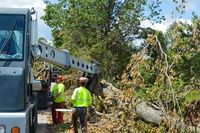When disaster strikes, Americans expect swift help from their government. But for many survivors of this year’s devastating storms, the wait for federal aid has stretched on—sometimes for months—leaving them in limbo as they struggle to rebuild their lives. Recent analysis and first-hand stories reveal a growing trend: the process of securing a presidential disaster declaration, the crucial step before federal funds flow, is taking longer than ever, with real consequences for those in harm’s way.
On September 11, 2025, President Donald Trump approved federal disaster aid for six states and several tribes reeling from spring and summer storms and floods. The declarations, announced by the White House, covered Kansas, North Carolina, North Dakota, Wisconsin, and tribal lands in Montana and South Dakota. Yet, in each case except Wisconsin, it took the administration more than a month to approve the requests—continuing a pattern of longer waits for disaster relief, as highlighted by a recent Associated Press analysis.
For those on the ground, these delays are more than bureaucratic headaches. In Tylertown, Mississippi, Buddy Anthony’s life was upended when a tornado with winds up to 140 mph ripped apart his home on March 15, 2025. With nowhere else to go, Anthony took shelter in his Ford F-250 under a carport, only to watch the storm destroy his house and damage his truck. “You wake up in the truck and look out the windshield and see nothing. That’s hard. That’s hard to swallow,” Anthony told the Associated Press. Forced to buy a used truck, he lived in it for weeks before federal aid arrived. Mississippi’s governor requested disaster assistance on April 1, but it took 50 days—until May 21—for President Trump to approve the request.
Anthony’s story isn’t unique. Across the country, survivors like Dana Grimes in Jayess, Mississippi, have found themselves in prolonged uncertainty. Grimes, whose insurance didn’t cover the full value of her damaged home, received only about $750 from FEMA for emergency expenses after the federal declaration. “We couldn’t figure out why the president took so long to help people in this country,” Grimes said. “I just want to tie up strings and move on. But FEMA—I’m still fooling with FEMA.”
Delays in disaster declarations mean individuals must wait longer for federal aid that covers daily living expenses, temporary lodging, and home repairs. Local officials, too, are left in the lurch, unsure if they’ll be reimbursed for debris cleanup and infrastructure repairs. In Walthall County, Mississippi, officials spent $700,000 on debris removal but had to suspend the effort for more than a month, unable to risk further expense without assurance of federal reimbursement. “We’re going to pay interest and pay that money back until FEMA pays us,” said Byran Martin, a county supervisor, highlighting the ripple effects of slow-moving aid.
The Associated Press analysis, corroborated by Mississippi Today and Mississippi Free Press, found the average wait for a presidential disaster declaration has steadily increased. In the 1990s and early 2000s, it took less than two weeks on average for a governor’s request to be granted. Over the past decade, that rose to about three weeks under presidents from both major parties. But during Trump’s current term, the average wait has ballooned to more than a month—almost 34 days—with some requests taking as long as 67 days to be approved.
In Wisconsin, August flooding left more than 1,500 homes destroyed or severely damaged at a cost exceeding $33 million, with public sector losses topping $43 million across six counties. Governor Tony Evers requested aid for residents in all six counties, but Trump’s approval, as of September 11, covered only three. “I will continue to urge the Trump Administration to approve the remainder of my request, and I will keep fighting to make sure Wisconsin receives every resource that is needed and available,” Evers said in a statement, pointedly thanking Democratic officeholders for their efforts but not Trump or any Republicans.
White House spokeswoman Abigail Jackson defended the administration’s approach, stating, “President Trump provides a more thorough review of disaster declaration requests than any Administration has before him.” She emphasized that Trump is committed to ensuring federal tax dollars “are spent wisely to supplement state actions, not replace them.” Jackson added, “Gone are the days of rubber stamping FEMA recommendations—that’s not a bug, that’s a feature.”
According to the AP, Trump has approved more than 30 major disaster declarations since taking office in January 2025. His approvals have ranged from a swift one-day turnaround after July’s deadly flash flooding in Texas to a 67-day wait following Michigan’s ice storm. The president has also announced several batches of disaster declarations on his social media platform, often highlighting his electoral victories and Republican officials in affected states. On September 11, he approved six major declarations in one day—a pace not unusual for his administration, which previously approved seven on July 22 and nine on May 21.
However, the delays have real-world impacts. Jonathan Young, who lost his 7-year-old son and his home in the Tylertown tornado, gave up on applying for FEMA aid due to the complexity of the process. “It’s a therapy for me,” Young said, “to pick up the debris that took my son away from me.”
Experts say the process for assessing and documenting disasters has grown more complex over time. Disasters themselves have become more frequent and intense, a trend scientists attribute to climate change driven by fossil fuel emissions. The Trump administration has reduced FEMA staff and reexamined the agency’s role, raising concerns among current and former employees about the nation’s disaster response capacity. A recently published letter from FEMA staff warned that staffing cuts and the elimination of long-term planning tools could become debilitating if a major disaster strikes.
Former FEMA Administrator Pete Gaynor, who served during Trump’s first term, argued that extra scrutiny of disaster requests “is probably the right thing to do, because I think the declaration process has become the ‘easy button’ for states.” Still, for disaster survivors, the wait can feel interminable. Chris Smith, who led FEMA’s individual assistance division under three presidents, said, “You want to keep the people where they are living. You want to ensure those communities are going to continue to be viable and recover. And the earlier that individual assistance can be delivered…the earlier recovery can start.”
In the meantime, many survivors have leaned on faith-based groups and neighbors for support. In Walthall County, volunteer firefighter Les Lampton said, “That’s the only thing that got us through this storm, neighbors helping neighbors. If we waited on the government, we were going to be in bad shape.”
While FEMA continues to cover three-fourths of public assistance costs and the full cost of individual aid as required by law, the Trump administration has not approved requests for hazard mitigation assistance—a tool that helps communities rebuild with greater resilience—since February 2025. Local officials are left making tough choices, sometimes delaying urgent repairs in the hope that federal money will eventually arrive.
For now, the nation’s disaster aid system faces mounting pressure, as climate-driven storms grow fiercer and the wait for help grows longer. For survivors like Anthony, Grimes, and Young, the hope is that the next time disaster strikes, help will come not just eventually, but when it’s needed most.

